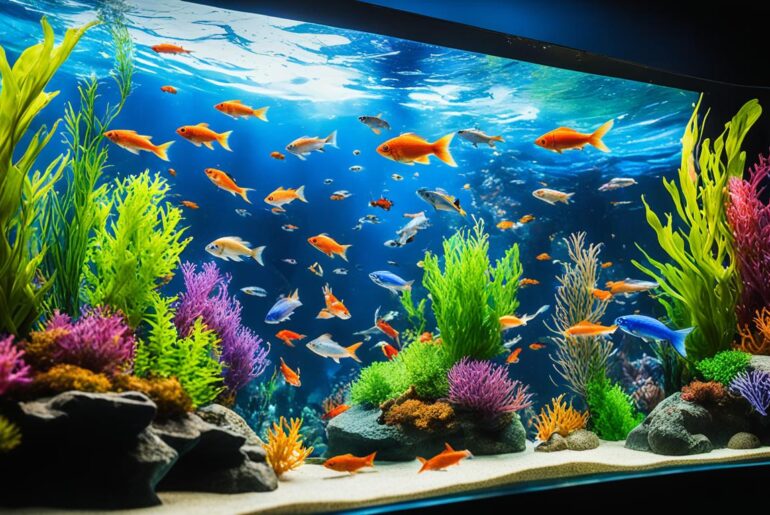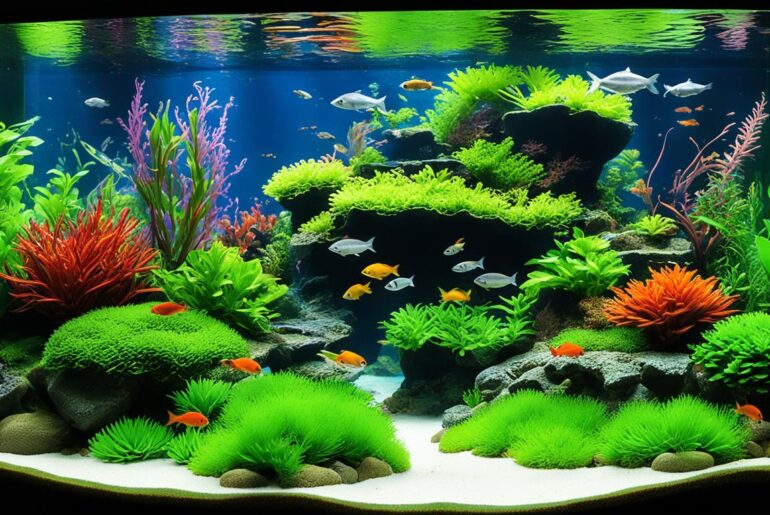When I first decided to venture into the world of freshwater aquariums, I was filled with excitement and anticipation. The idea of creating a serene underwater world in my own home was irresistible. But as I stood in front of row after row of fish tanks at the pet store, I felt a wave of uncertainty wash over me. Which fish would be the best fit for a beginner like me?
It’s a common dilemma that many aspiring fishkeepers face. With so many options to choose from, it can be overwhelming to know where to start. But fear not, fellow beginners! I am here to guide you through the process and share the top 7 best freshwater fish that are perfect for beginners like us.
Key Takeaways:
- Choosing the right freshwater fish can be intimidating, but there are many easy-to-care-for options for beginners.
- Rasboras, goldfish, tetras, corydoras, platies, betta fish, barbs, Bolivian cichlids, and kuhli loaches are all excellent choices for beginners.
- Consider factors such as tank size, compatibility with other fish, and ease of care when selecting your fish.
- Create a beautiful and thriving aquarium with these beginner-friendly fish that will bring joy and relaxation to your home.
- Remember to research each fish’s specific needs and provide them with a suitable environment to thrive.
Rasboras
Rasboras are small, peaceful fish that come in a variety of types. These delightful freshwater fish are perfect for beginners due to their easy care requirements and compatibility with other tankmates.
Harlequin Rasbora
The Harlequin Rasbora is a popular choice among fish enthusiasts for its striking appearance. With its bright orange color and distinctive black triangle patterns, this rasbora adds a beautiful touch to any aquarium. They are known for their peaceful nature and can be kept in a community tank with other non-aggressive fish.
Lambchop Rasbora
The Lambchop Rasbora is another eye-catching species that beginner aquarists love. These rasboras display a vibrant orange body coloration with a prominent dark black stripe. With their calm temperament and ability to thrive in a variety of water conditions, Lambchop Rasboras are an excellent choice for novice fish keepers.
Neon Green Rasbora
The Neon Green Rasbora is a unique rasbora species that stands out with its bright green coloration. With their peaceful nature and small size, these fish can comfortably fit in most community tanks. Their striking color adds a vibrant and lively touch to the aquarium environment.
Scissortail Rasbora
The Scissortail Rasbora, also known as the Sixbanded Rasbora, is a captivating fish species characterized by its elongated body and distinctive scissortail fin. These rasboras are known for their active nature and enjoy swimming around in groups. Their silver body coloration with black stripes makes them a visually appealing addition to any tank.
Rasboras, including Harlequin Rasboras, Lambchop Rasboras, Neon Green Rasboras, and Scissortail Rasboras, are readily available in most pet stores, making them easily accessible for beginners. Their peaceful temperament, vibrant colors, and adaptability make them a fantastic choice for any community tank.
Common Goldfish
Despite their reputation for needing large tanks, common goldfish are actually a great choice for beginners. They are very resilient and easy to care for. While they can grow quite large, they can be kept in a 30-gallon tank or even an outdoor pond. Common goldfish are forgiving with water parameters and can tolerate a variety of conditions.
Common goldfish, also known as Carassius auratus, are one of the most recognizable fish species in the world. With their vibrant colors and flowing fins, they make a stunning addition to any aquarium. But what makes them particularly beginner-friendly?
Firstly, common goldfish are incredibly hardy. They have been domesticated for centuries, which has made them resilient and adaptable. They can tolerate a wide range of water conditions and are forgiving when it comes to minor fluctuations in temperature and pH levels.
Secondly, common goldfish are not demanding when it comes to tank size. While they do grow quite large, their active swimming habits and need for open space can be accommodated in a 30-gallon tank. If you have the space, an outdoor pond can be an excellent option to provide them with a natural environment.
Lastly, common goldfish are relatively low-maintenance. They have a simple diet consisting of flakes or pellets, and they are not fussy eaters. They are generally peaceful and can coexist with other community fish that have similar tank requirements.
Overall, common goldfish are a great choice for beginners looking to start their aquarium journey. Their striking appearance, resilience, and ease of care make them an appealing option. Whether you choose to keep them in a tank or an outdoor pond, common goldfish will bring color and vibrancy to your aquatic environment.
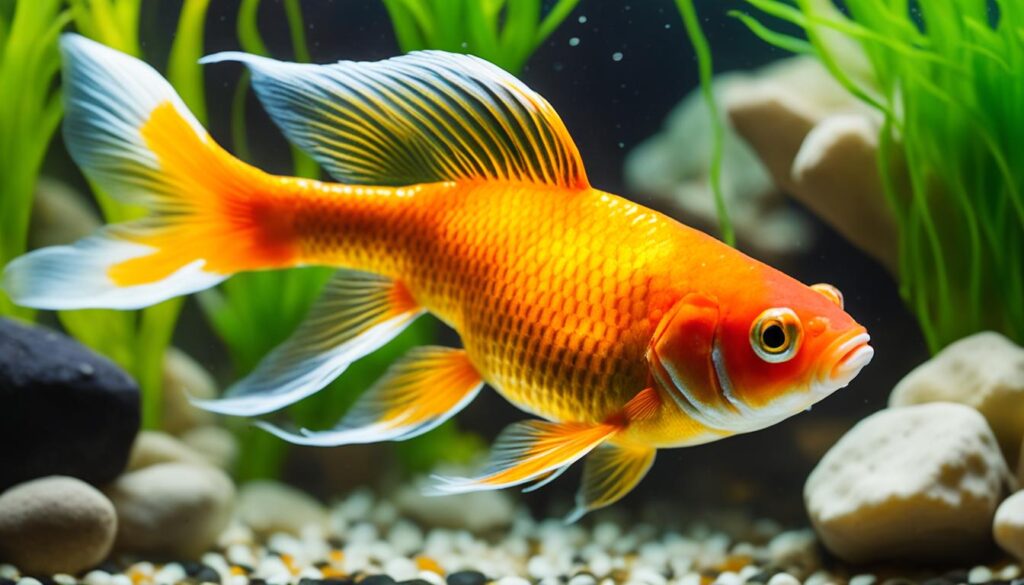
Tetras
Tetras are a popular choice for both beginner and experienced fish keepers. They come in a variety of colors and varieties, such as neon tetras, cardinal tetras, black neon tetras, and Congo tetras. These fish are easy to care for and do well in groups of six or more. Tetras are compatible with other community fish and can add a vibrant touch to any aquarium.
Neon tetras are known for their striking blue and red coloration, while cardinal tetras have bright red fins and a silver body. On the other hand, black neon tetras have a beautiful black color with vibrant neon blue stripes. Congo tetras are larger in size and have an elegant silver body adorned with shades of red and blue.
Tetras are peaceful and social fish, making them ideal for community aquariums. They thrive in well-maintained tanks with plenty of plants and hiding spots. It is recommended to keep tetras in groups of six or more to ensure their well-being and minimize stress.
These fish are relatively easy to care for and have a wide tolerance for different water parameters. They are omnivores and will readily accept a variety of food, including flakes, pellets, and frozen or live foods. Tetras are active swimmers, adding movement and color to your aquarium.
Tetra Species Comparison
| Tetra Species | Appearance | Size | Water Parameters | Group Size |
|---|---|---|---|---|
| Neon Tetra | Bright blue and red coloration | 0.75 – 1 inch (2 – 2.5 cm) | pH 5.5 – 7.0, temperature 72 – 78°F (22 – 26°C) | 6 or more |
| Cardinal Tetra | Bright red fins, silver body | 1.25 – 1.5 inches (3 – 4 cm) | pH 4.5 – 6.5, temperature 74 – 82°F (23 – 28°C) | 6 or more |
| Black Neon Tetra | Black color with neon blue stripes | 1 – 1.25 inches (2.5 – 3 cm) | pH 6.0 – 7.5, temperature 74 – 80°F (23 – 27°C) | 6 or more |
| Congo Tetra | Silver body with shades of red and blue | 3 – 4 inches (7.5 – 10 cm) | pH 5.5 – 7.5, temperature 75 – 82°F (24 – 28°C) | 6 or more |
Adding tetras to your aquarium will not only bring beauty but also create a lively and peaceful environment. With their vibrant colors and active nature, tetras are sure to captivate both beginner and experienced fish enthusiasts.
Corydoras
Corydoras, also known as cory catfish, are peaceful schooling fish that dwell at the bottom of the aquarium. These charming little fish are a great addition to any freshwater tank, bringing life and activity to the lower regions.
Popular species of corydoras include the bronze cory, albino cory, panda cory, and emerald green cory. Each species offers its unique coloration and patterns, adding visual interest to your aquarium.
Not only are corydoras visually appealing, but they also serve a practical purpose. These fish are known for their amusing behavior as they scuttle across the tank floor, searching for food and keeping the substrate clean. Their scavenging nature helps prevent the buildup of debris and waste, promoting a healthier tank environment.
To ensure the happiness and well-being of your corydoras, it’s best to keep them in groups of at least three to six of the same species. They thrive in a peaceful community tank with other non-aggressive fish, providing a harmonious atmosphere for all inhabitants.
Key Points:
- Corydoras, also known as cory catfish, are peaceful schooling fish that dwell at the bottom of the aquarium.
- Popular species include the bronze cory, albino cory, panda cory, and emerald green cory.
- They are known for their amusing behavior and are great at keeping the tank floor clean.
- Keep them in groups of at least three to six of the same species for their well-being.
Image:
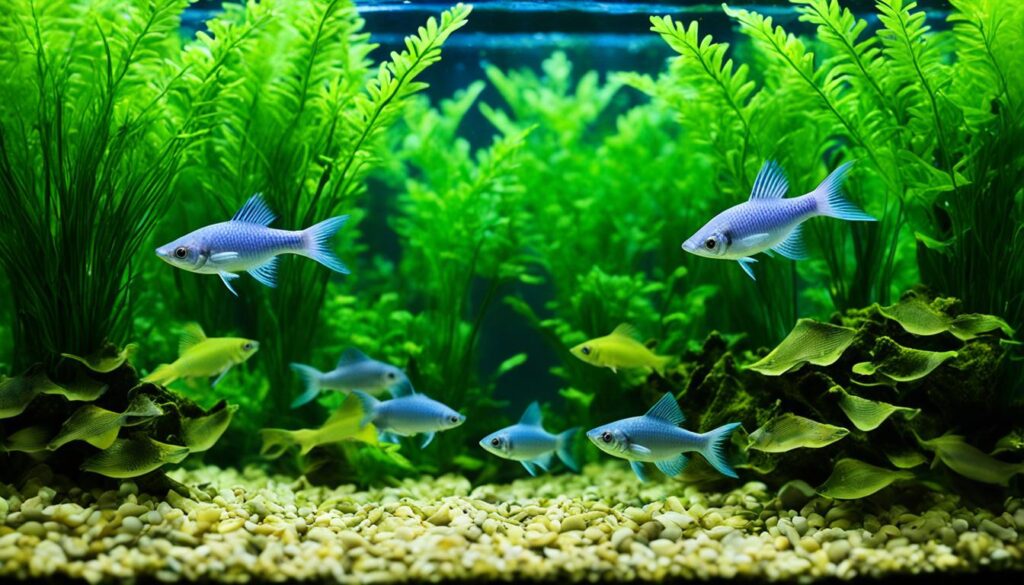
“Corydoras are delightful fish that bring both entertainment and practicality to your aquarium. Their peaceful nature, amusing behavior, and ability to keep the tank floor clean make them a favorite among fish enthusiasts.” – Expert Aquarist
Platies
When it comes to vibrant and easy-to-care-for freshwater fish, platies are an excellent choice for beginners. These robust livebearers can tolerate a wide range of pH levels, making them adaptable to different aquarium environments. Platies are known for their voracious appetite and will eagerly eat nearly any food you provide them with, from flakes to frozen or live foods.
One popular variety of platy is the variatus platy, which stands out with its vibrant and diverse colors. From fiery reds to striking blues and vivid yellows, these fish add a splash of color to any aquarium. They are great additions to a community tank, as they are peaceful and get along well with other peaceful fish species.
| Platies | Description |
|---|---|
| Physical Appearance | Small, colorful livebearers with a variety of vibrant patterns and shades. |
| Temperament | Peaceful and easygoing, suitable for community tanks. |
| Diet | Voracious eaters, willing to consume a variety of foods such as flakes, pellets, and live or frozen options. |
| Compatibility | Platies can coexist with other peaceful fish species. |
| Hardiness | Tolerant of different water parameters, making them resilient and easy to care for. |
Fun Fact:
Platies are known for their breeding habits. They are livebearers, meaning the females give birth to live young instead of laying eggs. This unique characteristic adds excitement to the aquarium as you may witness the birth of new platy fry.
If you’re looking for a beginner-friendly fish that adds color and liveliness to your aquarium, consider adding platies to your collection. Their adaptability, vibrant colors, and peaceful nature make them an excellent choice for fishkeepers of any experience level.

Betta Fish
When it comes to beginner-friendly fish, betta fish are at the top of the list. Also known as Siamese fighting fish, they are a favorite among hobbyists for their stunning colors and small size.
Betta fish can be kept either on their own in a small tank or as part of a peaceful community in a larger aquarium. They are known for their feisty nature, but with proper care and suitable tankmates, they can live harmoniously.
These beautiful fish require a varied diet to thrive. Betta pellets, frozen bloodworms, and other small floating foods should be included in their daily meals. A well-balanced diet ensures their health and vibrant colors.
Betta Fish Care Tips:
- Provide a tank with at least 5 gallons of water, preferably heated and filtered.
- Decorate the tank with plants and hiding spots to create a comfortable environment.
- Keep the water clean by performing regular water changes and maintaining appropriate water parameters.
- Monitor the behavior and health of your betta fish, looking out for signs of stress or illness.
- Ensure compatibility when choosing tankmates, avoiding aggressive or fin-nipping fish.
Despite their small size, betta fish have unique personalities and can bring joy and beauty to any aquarium. With their striking appearance and relatively low maintenance requirements, they are an excellent choice for beginners.
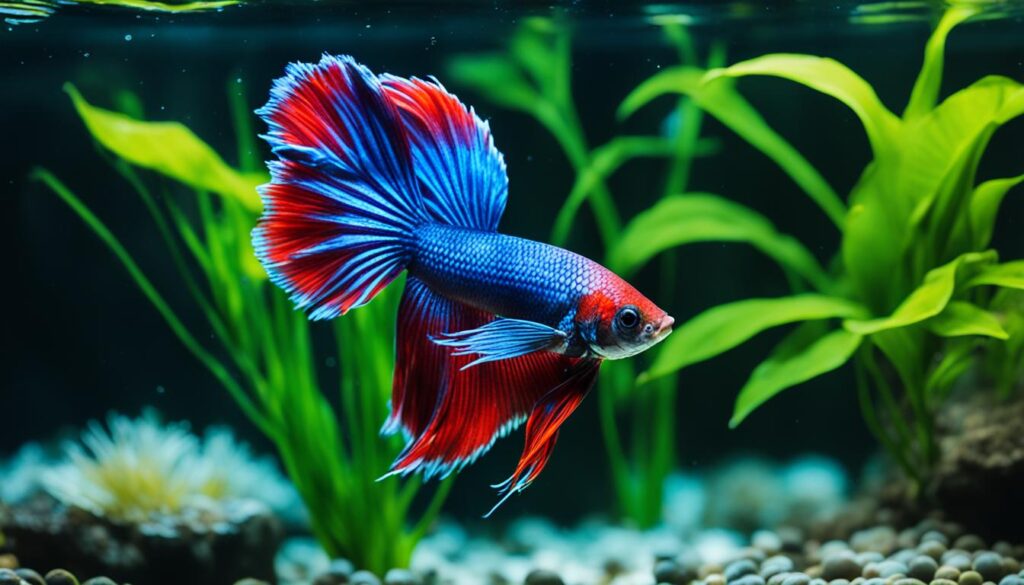
Comparison of Betta Fish Varieties
| Variety | Color | Pattern | Fin Shape |
|---|---|---|---|
| Halfmoon | Various | Irregular | Large and flowing |
| Plakat | Various | Varies | Shorter and more compact |
| Crowntail | Various | Wavy edges | Distinctly pointed |
| Veiltail | Various | Single-color or multicolored | Flowing and rounded |
Note: This table provides a brief comparison of some popular betta fish varieties. Colors, patterns, and fin shapes can vary significantly within each category. It is always recommended to research and select a betta fish that matches your preferences and tank setup.
Barbs
Barbs are lively fish that add action to any community tank. With their vibrant colors and active nature, they are a popular choice among aquarium enthusiasts. There are several varieties of barbs available, including:
- Tiger barbs
- Odessa barbs
- Cherry barbs
While some species of barbs can be semi-aggressive, they can still be great additions to a beginner’s aquarium when kept in groups of six or more. The key to keeping barbs successfully is to provide them with enough space and companionship. When barbs are kept in groups, they are less likely to exhibit aggressive behavior. In fact, they thrive in a community setting where they can interact with other fish.
Barbs are compatible with other fish like rasboras, tetras, and corydoras. Their active nature and striking colors make them a visually appealing addition to any aquarium. Just make sure to provide them with ample swimming space and plenty of hiding spots to keep them happy.
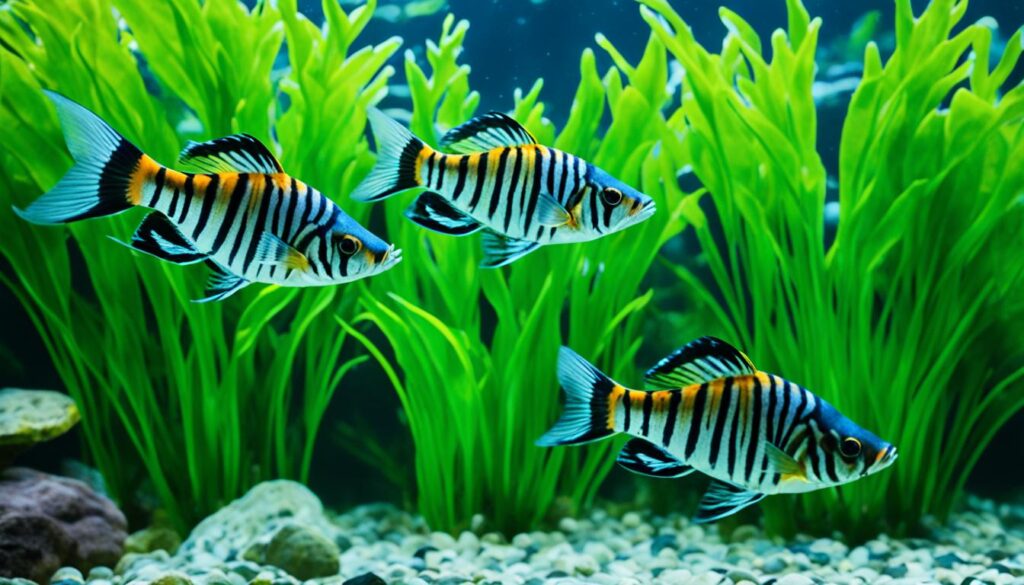
Adding barbs to your aquarium will undoubtedly bring excitement and energy to the tank. Their playful nature and social behavior will keep you entertained as you watch them interact with their tankmates. Create a dynamic and lively community tank by introducing barbs alongside other peaceful freshwater fish.
Bolivian Cichlids
When it comes to beginner cichlids from South America, Bolivian cichlids, especially the Bolivian ram, are an excellent choice. These colorful fish are known for their vibrant coloration and are relatively easy to breed. Whether you’re an experienced fish keeper or just starting out, Bolivian rams can be a great addition to your medium-sized community aquarium.
Water Requirements and Compatibility
Bolivian rams, as their name suggests, hail from Bolivia and prefer slightly acidic water conditions. Maintaining a pH range of 6.0-7.5 is ideal for these cichlids. They thrive in temperatures of 75-82°F and require a well-maintained aquarium with good filtration.
In terms of compatibility, Bolivian rams are generally peaceful and can coexist with other fish that have similar water requirements. Some suitable tankmates for Bolivian cichlids include tetras, rasboras, and small catfish species like corydoras.
Coloration and Breeding
Bolivian rams exhibit stunning color patterns, with vibrant blues, yellows, and reds adorning their bodies. This beautiful coloration intensifies during breeding periods, making them a visually striking addition to any aquarium.
Breeding Bolivian rams can be a rewarding experience for aquarists. These fish are known to form monogamous pairs and exhibit parental care. The female lays eggs on flat surfaces, and both parents take turns guarding the eggs and tending to the fry.
| Characteristic | Details |
|---|---|
| Common Names | Bolivian Ram, Bolivian Butterfly Cichlid |
| Scientific Name | Mikrogeophagus altispinosus |
| Origin | Bolivia |
| Difficulty Level | Beginner |
| Max Size | 3-4 inches |
| Water Parameters | pH 6.0-7.5, Temperature 75-82°F |
| Compatibility | Tetras, Rasboras, Corydoras |
If you’re looking to add colorful cichlids to your community aquarium, Bolivian rams are a fantastic choice. Their vibrant coloration, ease of breeding, and compatibility with other fish make them an excellent addition to any freshwater setup.
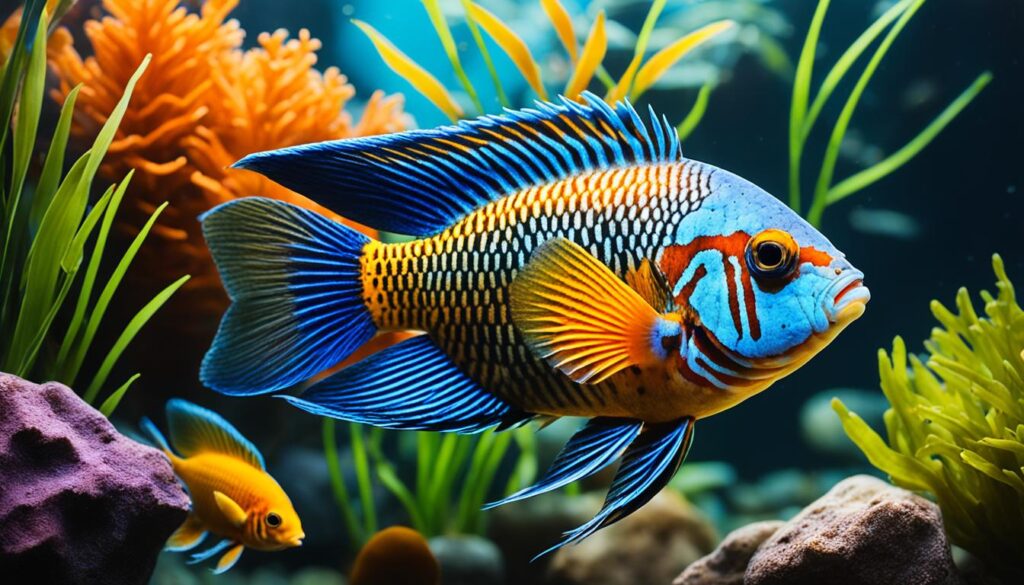
Kuhli Loaches
If you’re looking for a unique addition to your aquarium, consider Kuhli Loaches. These fascinating fish have an eel-like appearance that sets them apart from other freshwater species. With their slender bodies and intricate patterns, they make a captivating sight in any tank.
Kuhli Loaches are primarily bottom-dwellers, making them excellent scavengers. They constantly search for food on the ground, helping to keep your tank clean and free from debris. You’ll often find them hiding among decorations and plants, adding an element of mystery and intrigue to your aquatic landscape.
To ensure the health and happiness of your Kuhli Loaches, it’s best to keep them in small groups of three to six. They are social creatures that thrive when surrounded by their own kind. Creating a natural and secure environment for them with plenty of hiding spots will make them feel at home.
Feeding Kuhli Loaches is relatively easy. These voracious eaters will eagerly consume a variety of sinking foods, such as sinking granules or pellets. By offering them different types of food, you can ensure they receive a balanced diet and all the necessary nutrients.
By adding Kuhli Loaches to your aquarium, you not only introduce a fascinating species but also contribute to the overall diversity and harmony of your underwater world. Their distinctive appearance, behavior, and compatibility with other peaceful fish make them a delightful choice for both beginner and experienced fish keepers.
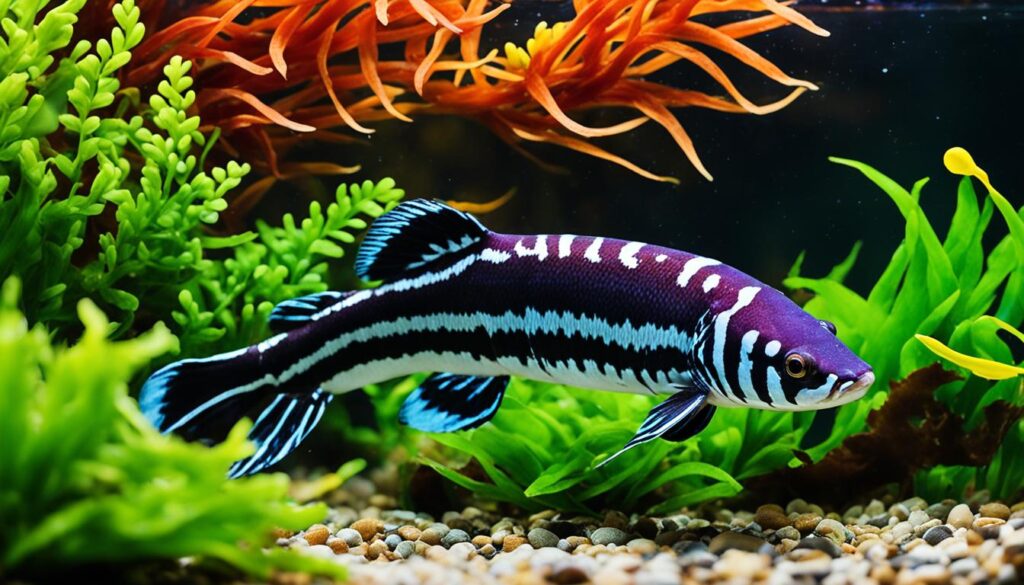
Interesting Facts about Kuhli Loaches:
- Kuhli Loaches are native to Southeast Asia, specifically Indonesia and Malaysia.
- They are part of the loach family, which includes various species known for their bottom-dwelling behavior.
- These fish are nocturnal, meaning they are most active during the night.
- Kuhli Loaches have delicate barbels on their faces, which they use to search for food.
- They prefer soft and slightly acidic water conditions, replicating their natural habitat.
Expert Tip:
If you want to observe the full range of Kuhli Loaches’ fascinating behavior, consider adding sand as substrate to your tank. Sand allows them to easily bury themselves, mimicking their natural hiding behavior and enhancing their overall well-being.
Conclusion
Choosing the best freshwater fish for beginners is an important decision when starting an aquarium hobby. The 7 fish listed here are all easy to care for, colorful, and budget-friendly options. Whether you choose rasboras, tetras, corydoras, or any other beginner-friendly fish, enjoy the journey of creating a beautiful aquarium that brings joy and relaxation to your life.
FAQ
What are the best freshwater fish for beginners?
The best freshwater fish for beginners include rasboras, common goldfish, tetras, corydoras, platies, betta fish, barbs, Bolivian cichlids, and Kuhli loaches.
What types of rasboras are recommended for beginners?
Harlequin rasbora, lambchop rasbora, neon green rasbora, and scissortail rasbora are popular rasbora choices for beginners.
Can common goldfish be kept in small tanks?
Although common goldfish can grow quite large, they can be kept in a 30-gallon tank or even an outdoor pond.
What are some popular varieties of tetras for beginners?
Neon tetras, cardinal tetras, black neon tetras, and Congo tetras are popular choices for beginners.
What are some popular species of corydoras for beginners?
Bronze cory, albino cory, panda cory, and emerald green cory are popular species of corydoras for beginners.
Can platies be kept with other fish?
Yes, platies can be kept in a community tank with other peaceful fish.
What are the care requirements for betta fish?
Betta fish require a varied diet of betta pellets, frozen bloodworms, and other small floating foods. They can be kept on their own in a small tank or with other peaceful fish in a larger aquarium.
Can barbs be aggressive?
Some species of barbs can be semi-aggressive, but when kept in groups of six or more, they can be great additions to a beginner’s aquarium.
Are Bolivian rams suitable for beginners?
Yes, Bolivian rams are excellent beginner cichlids from South America. They are known for their vibrant coloration and ease of breeding.
What is unique about kuhli loaches?
Kuhli loaches are unique with their eel-like appearance. They are bottom-dwellers and love scavenging for food on the ground and hiding among decorations and plants.
Which freshwater fish are recommended for beginners?
Rasboras, common goldfish, tetras, corydoras, platies, betta fish, barbs, Bolivian cichlids, and kuhli loaches are all recommended freshwater fish for beginners.
How can I choose the best fish for my freshwater aquarium?
When choosing fish for your freshwater aquarium, consider factors such as the size of your tank, water parameters, compatibility with other fish, and the level of care required for each species. Researching the specific needs and characteristics of each fish will help you make an informed decision.


